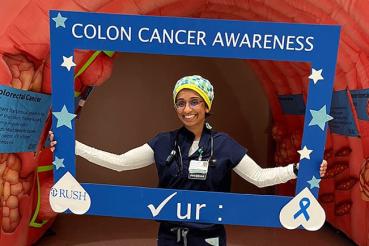If your doctor thinks you have an illness or disease in your small intestine, the double balloon enteroscopy technique can provide a closer look. It involves a special scope that lets your doctor move a camera more easily through your small intestine.
What is Double Balloon Enteroscopy?
The small intestine (small bowel) is a section between your stomach and your colon. Like a long string of pearls, the small intestine has many segments that can be difficult to move through with a traditional scope.
With a double balloon enteroscopy, a doctor uses a long, flexible tube called a scope with a camera and a light to look at your small intestine.
During balloon-assisted enteroscopy, the doctor can inflate and deflate small balloons attached to the scope. These balloons push and pull the camera through these segments in the small intestine. (Sometimes double balloon enteroscopy is called push-and-pull enteroscopy).
Why Do I Need an Enteroscopy?
Your doctor may recommend an enteroscopy if you’re experiencing symptoms, including unexplained bleeding, anemia, diarrhea or pain. Or you may have had an abnormal test result that means your doctor needs a closer look at your small intestine.
Many people who need the double balloon enteroscopy procedure have Crohn’s disease. Crohn’s disease is a condition in which the body’s own immune system begins attacking the small intestine, causing irritation and inflammation. Over time, this can lead to diarrhea, cramping, abdominal pain, anemia and other problems.
Double-balloon enteroscopy can help your doctor diagnose Crohn’s disease or determine whether your Crohn’s treatment is working.
Another common reason a doctor may recommend a double balloon enteroscopy is to check for suspected bleeding in the small intestine that can’t be seen with a regular endoscopy. With balloon enteroscopy, your physician can not only learn the cause of the bleeding but (in the majority of cases) can treat it.
A blockage in the small bowel is another situation where balloon enteroscopy can be helpful. This could be from a growth or narrowing of your small intestine, or from something you ate (foreign body).
Double balloon enteroscopy can also be used to get a biopsy of the abnormal areas of the small intestine that can’t be reached with regular endoscopy or colonoscopy.
What Should I Expect During My Double Balloon Enteroscopy?
Before your enteroscopy, you will need to fast for 12 hours. You may need an in-depth preparation, similar to colonoscopy prep.
Just before your procedure, you’ll be given medicine to make you sleepy. You won’t remember the procedure, and it won’t hurt.
During the procedure, doctors insert a tube (scope) with a light and camera at the end. The scope can be inserted orally, anally or both. They check the length of the small intestine, using the balloons on the scope to push-and-pull the camera through. It takes between one and three hours.
After the procedure, you will be given time to wake up. You can leave the same day, but you will need someone else to take you home. Your doctor will let you know how it went, what they found and if any follow-up care is needed.
What are the risks and benefits of double balloon enteroscopy?
Every medical procedure has risks and benefits. If you have double balloon enteroscopy, you may avoid surgery — along with longer recovery time and higher risks.
Risks of double balloon enteroscopy include sore throat, gas and abdominal discomfort and the side effects of anesthesia (including nausea, vomiting, low body temperature and headaches). You may also be at a slight risk for pancreas inflammation (pancreatitis). There is also a small risk of a tear in the lining of your small intestine (bowel perforation).
Because of these risks, your doctor may not perform double balloon enteroscopy until other options have been exhausted.
Why should I have my double balloon enteroscopy at Rush?
Our experts have trained for years to become among the best in Chicago and the nation for gastroenterology and GI surgery care. We offer the most thorough tests by well-trained doctors to treat rare, complex conditions. Our team of small bowel experts collaborate closely with our surgeons, radiologists and other advanced endoscopists to coordinate all aspects of your care.
If your doctor does find something concerning, we work closely with our oncology teams to immediately connect you with care — personalized for your condition.
Rush Excellence in Double Balloon Enteroscopy
- Expert endoscopists, dedicated to you: We know how important it is to get a test as soon as you need it. With years of training and experience, our fellowship-trained interventional endoscopists can help diagnose and treat complex issues.
- Ranked among the best: U.S. News & World Report ranked Rush among the best in the country for gastroenterology and GI surgery.
- Advanced facilities for advanced procedures: Located inside the Joan and Paul Rubschlager Building, our new facility has eight endoscopy suites. These dedicated suites feature the latest equipment and allow us to quickly see patients once referred.
- Coordinated care, from beginning to end: Following your enteroscopy, we work closely with your other doctors — whether that’s a primary care physician or another specialist.




